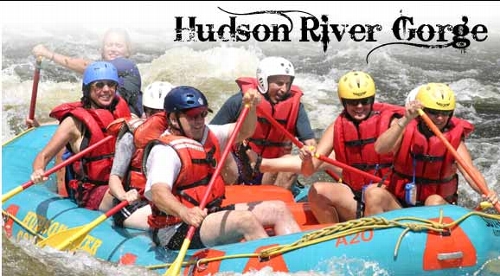Whitewater paddling is a great platform for an exciting day‐trip adventure. Many
companies around the world have capitalized on public interest in whitewater; these guide
companies take people with varying levels of experience out on rivers. There are 13
commercial raft companies in the Adirondacks with professional guides (Jenkins). These
companies send customers down stretches of Adirondack rivers, such as the Moose, the
Sacandaga, the Hudson, and the Black, in rafts that fit a maximum of ten people. [Include
map from Adirondack Atlas of locations of guide companies.] The companies send trips out
almost every day in every season except winter, so the guides memorize the rapids and
intricacies of the river. Even so, most companies require participants to sign a waiver about
liability because of the danger that whitewater paddling entails.
Waterways are public land in the Adirondacks, but the riverbanks are sometimes
private, so rafting companies have to plan out their riverbank stops on public land, or sites
that they own. The town of Indian Lake has capitalized on this venture and sold its land
along the Hudson to raft companies (Connelly).
Since rafts are larger than canoes and kayaks, and they are filled with air, they are
more fun on rapids with more water. Since kayaks and canoes are closer the surface of the
water and have little to no inflation, they can be exhilarating on lower class rapids. Rafting
companies time their trips with dam releases to maximize their participants’ excitement.
The large volume of water that is released by a dam over a short period of time is called a
“bubble”. The federal law called the Electric Consumer Protection Act requires dam
companies to have regularly scheduled whitewater releases in addition to other
requirements that protect the environment (Lessels). Rafting companies pay the town of
Indian Lake, which runs a dam, to releases a bubble on the companies’ schedule. With these
scheduled releases of a “bubble”, the paddling season last much longer than it used to when
paddlers had to depend on spring runoff.
When a company’s product is an dangerous as whitewater rafing, there are bound to
be some lawsuits. In the Adirondacks, the Hudson River Raft Company, owned by Patrick
Cunningham, has been guiding trips down Adirondack rivers since 1978
(hudsonriverrafting.com). In February 2013, the company faced charges concerning a trip
in September 2012 where an allegedly drunken guide took customers down Hudson River Gorge and
one of the customers, Tammy Blake, drowned on the trip. When this accident report came
out, other raft companies were concerned that it would scare customers away from the
sport of whitewater rafting in general. Whitewater rafting companies are a business and
therefore need to balance the enjoyment of their customers with safety. Tammy had signed
a waiver, as many rafting companies require, however the company was liable because of
the incapacitation of the guide (Connelly). Responsible rafting companies follow the safety
guidelines of organizations like AW, but not all rafting companies take the risk of
whitewater seriously.
Jenkins, Jerry, and Andy Keal. The Adirondack Atlas. Syracuse, NY: Syracuse UP, 2004. Print.
Connelly, Joe. "Death on the River." Blog post. Adirondack Life Blog Archive Death on the
River » Adirondack Life. Adirondack Life Magazine, June 2013. Web. 24 Feb. 2015.
Lessels, Bruce. Classic Northeastern Whitewater Guide. Boston, MA: Appalachian Mountain
Club, 1998. Print.
"Home. " Hudson River Rafting Company Rafting and Tubing Adventures on the Hudson,
Sacandaga, Moose Rivers and Black River Canyon. Web. 24 Feb. 2015.

